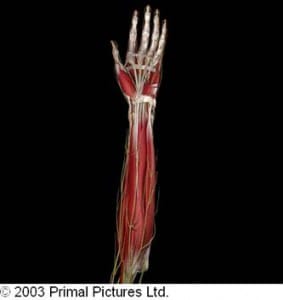GOLFER’S ELBOW/ MEDIAL EPICHONDYLITIS
The medical name for golfer’s elbow is medial epichondylitis, as this condition occurs where the tendons of the forearm insert onto the medial epichondyle of the elbow joint.

The medial epichondyle is the site at which the muscles which bend the wrist and fingers originate. The muscles which perform this function, and similarly share this common origin, include the flexor carpi radialis, pronator teres, palmaris longus, flexor carpi ulnaris and the flexor digitorum superficialis.
Medial epichondylitis is less frequently seen in the clinical setting than lateral epichondylitis, but both share the same pathophysiology, whereby overuse of the common flexor tendons affects the inherent structure of the tendon, leading to a tendinopathy. This may be due to excessive DIY, an improper golf swing (hence golfer’s elbow) or repetitive keyboard use. In fact, any action which places a repetitive and prolonged strain on the forearm muscles, coupled with inadequate rest, will tend to strain and overwork those muscles, leading to either lateral or medial epichondyltis.
Common symptoms described for this condition include elbow pain and possibly localised swelling close to the medial epichondyle of the elbow which come on initially following no real inciting trauma. The pain may refer further down the forearm and tends to get aggravated by bending the wrist. The patient may also report tingling into the fourth and little finger if there is irritation of the ulnar nerve resulting from an associated cubital tunnel syndrome.
Although inflammation may play a role in the initial pathogenesis of a tendinopathy, recent tendon research has uncovered that there is little or no evidence of inflammatory changes in the vast majority of tendon complaints and may explain why anti-inflammatory measures such NSAIDS (nurofen/ibuprofen) and ice have little effect in relieving symptoms. A supportive elbow strap may, however, help to reduce the tension on the muscle tendon complex of the common flexor tendon and help alleviate some of the symptoms arising from this condition.
One of the key elements in recovering from “golfer’s elbow” is deciphering which activities have taken place that initiated symptoms. From here, corrective training or ergonomic advice is paramount to prevent future episodes of elbow pain.
(The list of conditions given above and subsequent explanations are intended as a general guide and should not be considered a replacement for a full medical examination. Furthermore, we do not purport to treat all the conditions listed. Should you wish to discuss any of these conditions with our chiropractors, please do not hesitate to phone the clinic on 020 7374 2272 or email enquiries@body-motion.co.uk).
Our team of chiropractors and massage therapists are on hand to answer any questions you may have, so get in touch today via enquiries@body-motion.co.uk or on +44 (0)20 7374 2272.
